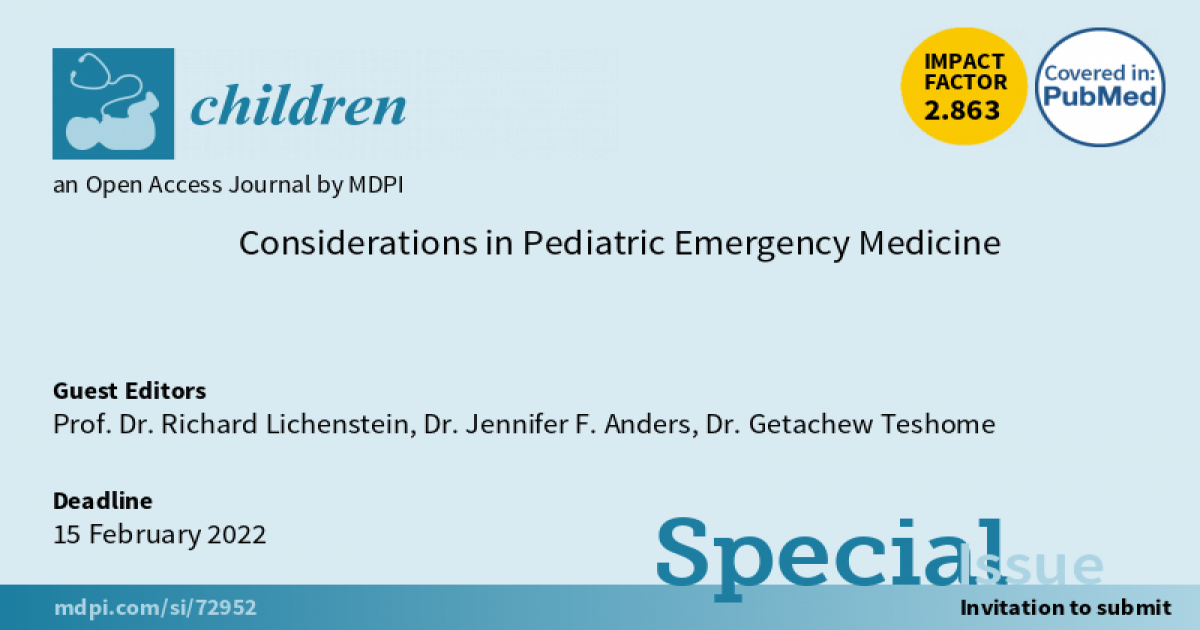Considerations in Pediatric Emergency Medicine
A special issue of Children (ISSN 2227-9067). This special issue belongs to the section "Pediatric Emergency Medicine & Intensive Care Medicine".
Deadline for manuscript submissions: closed (15 February 2022) | Viewed by 30087

Special Issue Editors
Interests: pediatric emergency medicine; injury prevention; disaster preparedness
Special Issues, Collections and Topics in MDPI journals
Interests: pediatric emergency research; fellowship training
Special Issue Information
Dear Colleagues,
Although the care of children in emergency situations has always been acknowledged, the development of pediatric emergency medicine into a more clearly described area of a pediatric subspecialty has only been seen over the last 40 years. Pediatric emergency medicine now encompasses not only direct care in the emergency department but also prehospital care, innovations in diagnostic testing, and radiology advances, as well as advancements in medical and trauma care. In addition, pediatric emergency medicine also incorporates quality improvement initiatives to improve the safety and quality of emergency care in all settings, including community emergency departments, academic medical centers, and children’s hospitals and urgent care facilities. This Special Issue addresses a wide variety of topics that surround pediatric emergency medicine that have previously been rarely considered or have developed with new innovations or scientific advances. We recognize the tremendous growth and scope of pediatric emergency medicine which continuously encourages us to assess all evidence and experience so that we can continue to strive to provide the best care possible for the populations we treat.
Prof. Richard Lichenstein
Dr. Jennifer F. Anders
Dr. Getachew Teshome
Guest Editors
Manuscript Submission Information
Manuscripts should be submitted online at www.mdpi.com by registering and logging in to this website. Once you are registered, click here to go to the submission form. Manuscripts can be submitted until the deadline. All submissions that pass pre-check are peer-reviewed. Accepted papers will be published continuously in the journal (as soon as accepted) and will be listed together on the special issue website. Research articles, review articles as well as short communications are invited. For planned papers, a title and short abstract (about 250 words) can be sent to the Editorial Office for assessment.
Submitted manuscripts should not have been published previously, nor be under consideration for publication elsewhere (except conference proceedings papers). All manuscripts are thoroughly refereed through a single-blind peer-review process. A guide for authors and other relevant information for submission of manuscripts is available on the Instructions for Authors page. Children is an international peer-reviewed open access monthly journal published by MDPI.
Please visit the Instructions for Authors page before submitting a manuscript. The Article Processing Charge (APC) for publication in this open access journal is 2400 CHF (Swiss Francs). Submitted papers should be well formatted and use good English. Authors may use MDPI's English editing service prior to publication or during author revisions.
Keywords
- Pediatric prehospital care
- Pediatric emergency radiology
- Pediatric trauma
- Pediatric interfacility transfer
- Appendicitis
Benefits of Publishing in a Special Issue
- Ease of navigation: Grouping papers by topic helps scholars navigate broad scope journals more efficiently.
- Greater discoverability: Special Issues support the reach and impact of scientific research. Articles in Special Issues are more discoverable and cited more frequently.
- Expansion of research network: Special Issues facilitate connections among authors, fostering scientific collaborations.
- External promotion: Articles in Special Issues are often promoted through the journal's social media, increasing their visibility.
- Reprint: MDPI Books provides the opportunity to republish successful Special Issues in book format, both online and in print.
Further information on MDPI's Special Issue policies can be found here.







